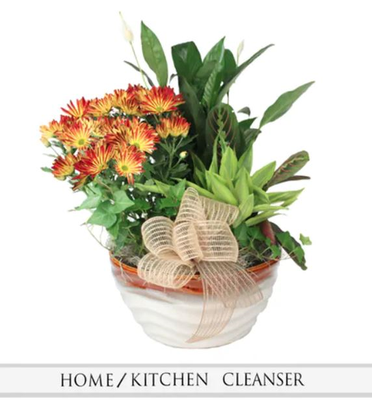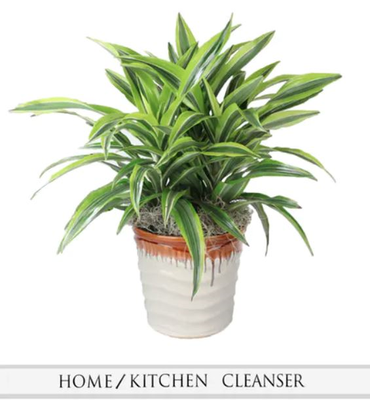Healthy Plants Collection
Healthy Plants Collection
Nanz & Kraft Florists
Nanz & Kraft Florists has partnered with the Center for Healthy Air, Water, & Soil at the Christina Lee Brown Envirome Institute to offer the Healthy Plants Collection. The Healthy Plants Collection will bring greenness to your indoor environment and can help improve mental wellbeing and air quality!
Most people spend the majority of their time indoors in homes, offices, and hospitals where pollutants such as benzene, formaldehyde, xylene, and ammonia are common. Furniture, building materials, office equipment, and everyday activities like driving, cleaning, and cooking give off these pollutants that can cause distraction, headache, dizziness, and eye, nose, and throat irritation.
Sometimes, the easiest treatment is simply eliminating exposure to the source of the pollution – plants in the Healthy Plant Collection have the ability to trap airborne toxins on their leaf surface so you won’t breathe it in.
Nanz & Kraft Florists donates $10 from each
purchase within the collection to help fund
scientific research to improve health in Louisville.
Our Part:
Guided by the philosophy of the Circle of Harmony and Health, the Institute for Healthy Air Water & Soil works to help people understand the connections between their health and their environment.
The Center for Healthy Air, Water, and Soil is building a living, urban laboratory to support collaborative research and promote a health in all policies approach to decision making at the University of Louisville. We bring people and data together to begin new conversations and find new solutions to health challenges in our community and around the world.
The Envirome Institute at University of Louisville’s School of Medicine engages researchers and citizen scientists to learn how our natural, social, and personal environments impact health. The Envirome’s faculty and research teams explore and work to understand the relationships between the environment and human health.
Indoor Air Quality:
“Plants produce their own food through a process called photosynthesis. This means they take in carbon dioxide from the atmosphere and release oxygen. Photosynthesis "cleans" our air by absorbing carbon dioxide and by taking in certain other pollutants as well.
A team of National Aeronautics and Space Administration (NASA) researchers lead by Dr. Bill Wolverton tested the effect of fifteen house plants on three pollutants known to be present in spacecrafts. These same three pollutants--benzene, formaldehyde and trichloroethylene--are present in homes and office buildings. They occur because they are emitted from furnishings, office equipment and some building materials.
The NASA researchers suggest that for the test plants to be effective "air cleaners" it is necessary to use 1 potted plant per 100 square feet of home or office space.”
-Laura Pottorff, Cooperative Extension, Colorado State University
Where Can these Pollutants Appear?
Office
Common office materials like printing vapor, synthetic fibers of furniture and carpet, furniture glue, plywood, and particle board release formaldehyde, benzene, and xylene into the air. These chemicals can cause eye, ear, nose and throat irritation, increased heart rate, headache, asthma attacks. These plants can scrub your indoor air to increase work outcomes for the entire office.
Hospital
Every hospital patient deserves their own personal garden. Not only do plants promote healing, but a variety of airborne toxins such as ammonia, xylene, and formaldehyde, contaminate the indoor air of hospitals which can cause people to feel sick longer. These plants scrub the air of toxins from cleaning agents and other medical activities that are common in hospitals and other medical facilities.
Home
Our households are very busy places from the kitchen to the DIY project spaces. Kitchen activities and DIY projects cause airborne pollutants which can cause eye, ear, nose, and throat irritation and cough. Paper products like napkins and paper towels release formaldehyde and many cleaners contain ammonia. DIY projects can include the use of adhesives, sprays, glues, paints, and lacquers that release airborne toxins such as xylene, and trichloroethylene.
What’s in the Air?
Formaldehyde
- In paper bags, wax paper, facial tissue, paper towels, napkins, particle board, plywood, synthetic fibers, paints, wallpapers, glues, adhesives, varnishes, lacquers
- Causes ear, nose, and throat irritation, larynx and lung inflammation
Benzene
- In plastics, synthetic fibers, detergent, drugs, pesticides, tobacco smoke, vehicle exhaust
- Causes eye irritation, increased heart rate, headache
Xylene
- From printing, leather/paint industry, tobacco smoke, vehicle exhaust
- Causes throat irritation, headache, heart, liver, and kidney problems
Trichloroethylene
- From printing ink, paint, lacquer, adhesives, paint remover
- Causes headache, dizziness, nausea
Ammonia
- In household or industrial cleaners and fertilizer
- Causes eye irritation, cough, sore throat
How Plants in the Healthy Plants Collection Help:
- Scrubs indoor air of toxins
- Reduces stress level
- Improves mood and decrease stress-related depression
- Improves sickness and injury recovery
- Improves job satisfaction
- Increases concentration and memory
- Increases compassion and empathy
- Increases energy level




